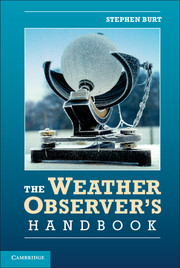Book contents
- Frontmatter
- Contents
- Acknowledgements
- Abbreviations, footnotes and references
- Part One The basics
- Part Two Measuring the weather
- 5 Measuring the temperature of the air
- 6 Measuring precipitation
- 7 Measuring atmospheric pressure
- 8 Measuring humidity
- 9 Measuring wind speed and direction
- 10 Measuring grass and earth temperatures
- 11 Measuring sunshine and solar radiation
- 12 Observing hours and time standards
- 13 Dataloggers and AWS software
- 14 Non-instrumental weather observing
- 15 Calibration
- 16 Metadata – what is it, and why is it important?
- Part Three Making the most of your observations
- Appendix 1 Metrology and meteorology: The basics of instrument theory
- Appendix 2 Useful functions
- Appendix 3 Unit conversions
- Appendix 4 Useful sources
- Index
- References
11 - Measuring sunshine and solar radiation
Published online by Cambridge University Press: 05 July 2012
- Frontmatter
- Contents
- Acknowledgements
- Abbreviations, footnotes and references
- Part One The basics
- Part Two Measuring the weather
- 5 Measuring the temperature of the air
- 6 Measuring precipitation
- 7 Measuring atmospheric pressure
- 8 Measuring humidity
- 9 Measuring wind speed and direction
- 10 Measuring grass and earth temperatures
- 11 Measuring sunshine and solar radiation
- 12 Observing hours and time standards
- 13 Dataloggers and AWS software
- 14 Non-instrumental weather observing
- 15 Calibration
- 16 Metadata – what is it, and why is it important?
- Part Three Making the most of your observations
- Appendix 1 Metrology and meteorology: The basics of instrument theory
- Appendix 2 Useful functions
- Appendix 3 Unit conversions
- Appendix 4 Useful sources
- Index
- References
Summary
“The number of hours the Sun is visible each day . . . is of interest to the meteorologist, the climatologist, the horticulturalist, the biologist, and even the local Chamber of Commerce.”
So began Norman Foster and Laurence Foskett’s description of their new photoelectric sunshine recorder in May 1953 [1]. Today, the climatologist and biologist might prefer a global solar radiation value instead of sunshine hours, but it is likely that few non-specialist members of the public would be immediately familiar with the detail and units of solar radiation records. It is certain, however, that most would recognize ‘11 hours of sunshine’ as being a sunny day.
This chapter covers the instruments and methods used to measure both sunshine and solar radiation. Broadly, measurements of ‘solar radiation’ refer to the interception of radiant electromagnetic energy emanating from the Sun (which can be measured at the top of the atmosphere by satellites, or at the Earth’s surface). Our eyes are sensitive to only a part of this stream of radiation, some of which is absorbed and reflected in its passage through the Earth’s atmosphere. Measurements of ‘sunshine’ refer more specifically to the appearance or otherwise of the solar disk, and more particularly shadows cast by the Sun, when viewed from the surface of the Earth. ‘Sunshine’ can therefore be considered as a binary (yes/no) condition, occurring only when visible solar radiation exceeds a particular threshold. Solar radiation measurements are therefore the more complete, and provide more useful and precise values for solar energy input, whether that be to a domestic solar panel or a supercomputer-based global climate model. However, presence or absence of sunshine is often the more significant in terms of human perception and health.
- Type
- Chapter
- Information
- The Weather Observer's Handbook , pp. 232 - 270Publisher: Cambridge University PressPrint publication year: 2012



